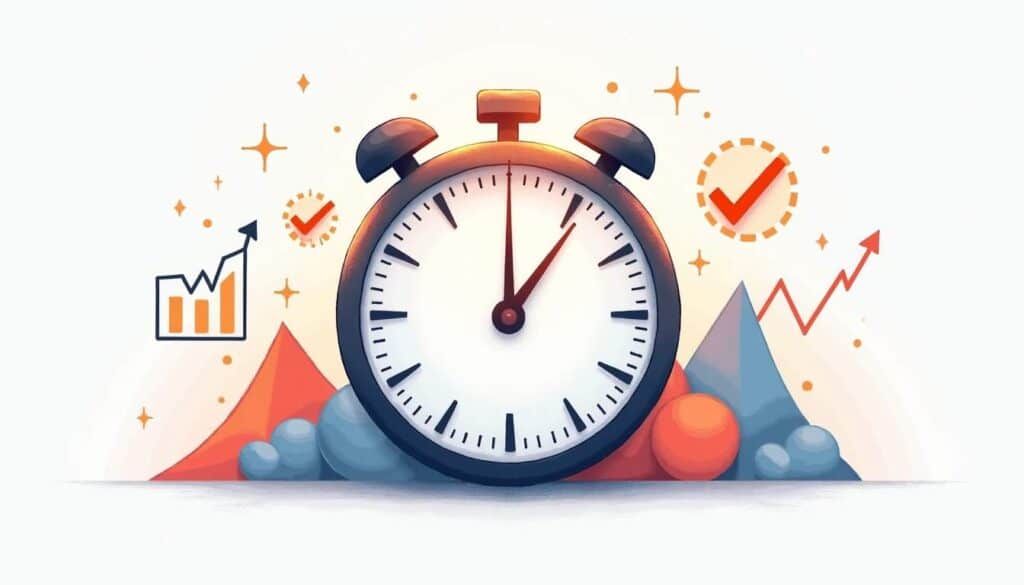Table of Contents
In the fast-paced world of digital marketing, every millisecond counts—especially when it comes to Google Ads landing pages. A slow-loading landing page can mean the difference between capturing a potential customer’s interest or losing them to a competitor. With mobile users becoming the dominant audience and Google’s increasing emphasis on page speed, optimizing your landing page load times is no longer optional; it’s essential.
Why Landing Page Speed Matters More Than Ever
It’s no secret that users expect websites to load quickly. But the stakes are higher when it comes to Google Ads landing pages, where visitors arrive with intent and are primed to take action. Unfortunately, many pages still fail to meet these expectations. For instance, the average mobile webpage takes a staggering 15 seconds to load—far beyond the recommended 3-second benchmark.
This delay isn’t just an inconvenience; it directly impacts your bottom line. Research shows that 53% of mobile site visitors abandon a page that takes longer than three seconds to load. That means over half of your potential customers might never even see your offer if your landing page is sluggish.
Moreover, Google’s “Speed Update” now factors page speed into its mobile search algorithm, making fast-loading pages more likely to rank higher. This means that slow landing pages not only frustrate users but also hurt your ad’s visibility and effectiveness.
In addition to user abandonment, slow loading times can also lead to a negative perception of your brand. Users often associate the speed of a website with the quality of the service or product being offered. If a landing page takes too long to load, potential customers may question the reliability of your business, leading them to seek alternatives. This is particularly crucial in competitive markets where first impressions can make or break a sale.
Furthermore, optimizing your landing page speed can enhance the overall user experience, leading to higher engagement rates. When pages load quickly, users are more likely to explore additional content, interact with calls to action, and ultimately convert. Tools like Google PageSpeed Insights can help identify areas for improvement, allowing you to streamline images, leverage browser caching, and minimize JavaScript to ensure a smoother experience for your visitors.
The Real Cost of Slow Landing Pages
Conversion Rates Take a Hit
Speed isn’t just about user experience—it’s a critical business metric. Studies reveal that a mere 1-second delay in mobile page load time can reduce conversions by up to 7%. Even smaller delays matter: a 100-millisecond lag can cause a 7% drop in conversion rates. When you’re paying for clicks, losing even a fraction of conversions translates to wasted ad spend and missed revenue. Furthermore, the implications of slow landing pages extend beyond immediate financial losses. They can also affect your brand’s reputation. Users often associate slow load times with a lack of professionalism, which can lead to long-term trust issues. In an era where consumers have countless options at their fingertips, a slow page can mean losing potential customers to competitors who offer a faster, more seamless experience.
Bounce Rates Skyrocket With Slow Loads
Landing page speed also influences bounce rates dramatically. Pages that load in just 1 second enjoy a bounce rate of only 9%, whereas those that take 5 seconds see bounce rates jump to 38%. This means slow pages push visitors away before they even engage with your content or offers. Additionally, the impact of high bounce rates can ripple through your analytics, skewing your data and making it difficult to gauge the effectiveness of your marketing strategies. A high bounce rate may signal to search engines that your content is not relevant or engaging, which can further harm your SEO rankings. As a result, not only do you lose potential customers, but you also risk diminishing your visibility in search engine results, creating a vicious cycle that can be hard to break.
Performance as a Competitive Edge
Experts like Addy Osmani and Ilya Grigorik from Chrome for Developers emphasize that “performance is a feature and a competitive edge.” Optimized web experiences don’t just keep users happy—they lead to higher engagement, better conversions, and ultimately, a stronger return on investment (ROI). In the crowded landscape of Google Ads, speed can be the factor that sets your campaign apart. Companies that prioritize performance often find themselves reaping the benefits of increased customer loyalty and repeat visits. Moreover, as mobile usage continues to rise, the importance of fast-loading pages becomes even more pronounced. Mobile users are particularly impatient; they expect instant gratification. If your landing page fails to meet their expectations, the likelihood of them returning diminishes significantly, making it essential to invest in speed optimization as part of your overall digital strategy.
Key Metrics to Track for Landing Page Performance
Understanding how your landing page performs is the first step toward improvement. Google’s Core Web Vitals provide a useful framework, focusing on metrics like Largest Contentful Paint (LCP), which measures loading performance. As of early 2025, about 66.7% of websites achieve a “good” LCP score, but only 51.8% meet the overall Core Web Vitals standards.

Tracking these metrics helps identify bottlenecks and prioritize fixes that will have the most impact. For Google Ads landing pages, aiming for an LCP under 2.5 seconds is a good rule of thumb to ensure fast, smooth experiences.
Another crucial metric to consider is First Input Delay (FID), which gauges the responsiveness of a page. A low FID score indicates that users can interact with your landing page almost immediately after it loads, enhancing the overall user experience. As of early 2025, the benchmark for a good FID score is under 100 milliseconds, a target that can significantly influence user engagement and conversion rates. By optimizing scripts and minimizing third-party dependencies, you can improve your FID and create a more seamless interaction for your visitors.
Additionally, Cumulative Layout Shift (CLS) is vital in ensuring visual stability as your page loads. A high CLS score can lead to frustrating experiences, as elements shift unexpectedly, causing users to click on the wrong buttons or links. Keeping your CLS score below 0.1 is ideal, and this can be achieved by specifying size attributes for images and videos, as well as avoiding inserting new content above existing content. By focusing on these metrics, you not only enhance user satisfaction but also improve your page’s ranking in search engine results, leading to increased visibility and traffic.
Practical Strategies to Speed Up Your Google Ads Landing Pages
1. Optimize Images and Media
Images often account for the majority of a page’s load time. Compressing images without sacrificing quality, using modern formats like WebP, and implementing lazy loading can drastically reduce load times. Avoid auto-playing videos or heavy media that can bog down mobile connections. Furthermore, consider using responsive images that adjust based on the user’s device, ensuring that only the necessary resolution is loaded for optimal performance. This not only enhances speed but also improves user experience, as visitors will appreciate faster loading times and less data consumption on mobile devices.

2. Minimize and Streamline Code
Excessive JavaScript and CSS can delay rendering. Minifying code, removing unused scripts, and deferring non-critical JavaScript help pages load faster. Tools like Google’s PageSpeed Insights can highlight specific code-related issues. Additionally, consider adopting asynchronous loading for scripts that are not essential for the initial rendering of the page. This allows the browser to load content more efficiently, improving perceived performance and user engagement. Regularly reviewing and updating your codebase can also help maintain optimal speed as web standards evolve.
3. Leverage Fast Hosting and Content Delivery Networks (CDNs)
Choosing a reliable, fast web host and utilizing CDNs ensures your landing page content is delivered quickly to users regardless of their geographic location. This reduces latency and improves overall speed. Moreover, a good CDN can cache your content at various locations around the world, ensuring that users access data from the nearest server. This not only enhances load times but also provides redundancy, ensuring your site remains accessible even during traffic spikes or server outages. Evaluating your hosting provider’s performance metrics can help you make informed decisions about the best options for your needs.
4. Prioritize Mobile Optimization
Since most Google Ads traffic is mobile, designing landing pages with mobile-first principles is crucial. Responsive layouts, easy-to-tap buttons, and streamlined content all contribute to faster load times and better user experiences. Additionally, implementing mobile-specific features, like touch-friendly navigation and simplified forms, can further enhance usability. As mobile devices vary widely in screen size and capabilities, testing your landing pages across different devices and browsers ensures a consistent experience for all users, ultimately leading to higher conversion rates.
5. Reduce Redirects and Server Response Times
Each redirect adds extra time to page load, so minimizing redirects is essential. Additionally, optimizing server performance to reduce response times can shave valuable seconds off your load speed. Consider using tools to monitor server performance and identify bottlenecks that may be affecting response times. Implementing caching strategies, such as browser caching and server-side caching, can also significantly improve load speeds by storing frequently accessed data closer to the user. This proactive approach not only enhances user satisfaction but can also positively impact your search engine rankings, as page speed is a critical factor in SEO.
Testing and Monitoring for Continuous Improvement
Improving landing page speed is not a one-time task. Regular testing using tools like Google PageSpeed Insights, Lighthouse, or WebPageTest allows you to monitor performance and catch new issues early. A/B testing different page versions can also reveal which optimizations yield the best results in terms of conversions and engagement. By experimenting with various elements such as headlines, images, and call-to-action buttons, you can gather valuable data on user preferences and behaviors. This iterative process not only enhances user experience but also drives higher conversion rates, making it an essential practice for any digital marketer.
Keeping an eye on Core Web Vitals and bounce rates over time helps ensure your landing pages remain fast and effective as you update content or add new features. These metrics, which include loading performance, interactivity, and visual stability, are critical indicators of user experience. Regularly reviewing these statistics allows you to identify trends and potential problem areas before they escalate into larger issues. Additionally, integrating user feedback through surveys or usability testing can provide deeper insights into how visitors interact with your pages, enabling you to make informed decisions that align with their needs and expectations.
Moreover, leveraging heatmaps and session recordings can further enhance your understanding of user behavior. These tools visualize where users click, scroll, and spend the most time, offering a granular view of engagement patterns. By analyzing this data, you can pinpoint specific sections of your landing page that may require optimization or redesign. This comprehensive approach to testing and monitoring not only fosters a culture of continuous improvement but also ensures that your landing pages remain competitive in an ever-evolving digital landscape.
Conclusion: Speed Is Your Secret Weapon in Google Ads
Google Ads campaigns demand precision and efficiency, and landing page speed plays a pivotal role in campaign success. With over half of mobile visitors abandoning slow pages and conversion rates dropping significantly with each delay, optimizing load times is a clear path to better engagement and ROI.

By focusing on key performance metrics, implementing practical speed improvements, and continuously monitoring your landing pages, you can create seamless experiences that delight users and drive results. In today’s competitive digital landscape, speed isn’t just a technical detail—it’s a strategic advantage that can make or break your Google Ads performance.



